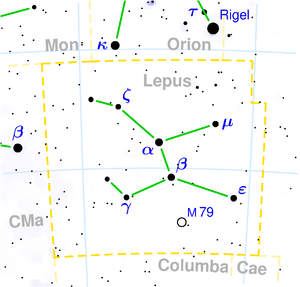Eta de la Llebre
Eta de la Llebre (η Leporis) és un estel de magnitud aparent +3,72 en la constel·lació de la Lepus.[9] Es troba a 49 anys llum del Sistema Solar.
Eta de la Llebre és un estel blanc-groc de la seqüència principal de tipus espectral F1V o F2V amb una temperatura superficial de ~7000 K. Té un radi un 50% major que el radi solar i rota amb una velocitat igual o superior a 26 km/s.[10][11] El seu contingut metàl·lic correspon aproximadament a la meitat del que té el Sol.[10] Posseeix una massa de 2,3 masses solars[12] i es pensa que és un estel més jove que el Sol, amb una edat aproximada de 1300 o 1800 milions d'anys —la dada varia segons la font consultada—.
De característiques físiques similars a η Corvi o β Trianguli Australis, coincideix amb la primera en què s'ha detectat un excés de radiació infraroja —tant a 70 com a 24 μm— procedent de l'estel. Això indica la presència d'un disc circumestel·lar de pols entorn d'Eta de la Llebre, la temperatura de la qual pot ser d'uns 165 K. Estudis duts a terme amb el Telescopi espacial Spitzer suggereixen que la part central del disc està buidada, la qual cosa pot implicar la presència de planetes.[13][12]
Referències
[modifica]- ↑ Christopher J. Corbally «Contributions to the Nearby Stars (NStars) Project: Spectroscopy of Stars Earlier than M0 within 40 pc--The Southern Sample» (en anglès). Astronomical Journal, 1, 02-06-2006, pàg. 161–170. DOI: 10.1086/504637.
- ↑ 2,0 2,1 2,2 2,3 2,4 2,5 Afirmat a: Gaia Early Data Release 3. Indicat a la font segons: SIMBAD. Llengua del terme, de l'obra o del nom: anglès. Data de publicació: 3 desembre 2020.
- ↑ Michael W. McElwain «Characterization of Dusty Debris Disks: The IRAS and Hipparcos Catalogs» (en anglès). Astrophysical Journal, 2, 10-05-2007, pàg. 1556-1571. DOI: 10.1086/509912.
- ↑ Afirmat a: Catalogue of Stellar Photometry in Johnson's 11-color system. Indicat a la font segons: SIMBAD. Llengua del terme, de l'obra o del nom: anglès. Data de publicació: 2002.
- ↑ «Lithium abundance patterns of late-F stars: an in-depth analysis of the lithium desert» (en anglès). Astronomy and Astrophysics, 12-06-2018, pàg. 55–55. DOI: 10.1051/0004-6361/201732209.
- ↑ David Montes «Chromospheric activity and rotation of FGK stars in the solar vicinity» (en anglès). Astronomy and Astrophysics, setembre 2010, pàg. 79–79. DOI: 10.1051/0004-6361/200913725.
- ↑ Afirmat a: Gaia Data Release 2. Indicat a la font segons: SIMBAD. Llengua del terme, de l'obra o del nom: anglès. Data de publicació: 25 abril 2018.
- ↑ 8,0 8,1 «Lithium abundances in nearby FGK dwarf and subgiant stars: internal destruction, galactic chemical evolution, and exoplanets» (en anglès). Astrophysical Journal, 1, 13-08-2012, pàg. 46. DOI: 10.1088/0004-637X/756/1/46.
- ↑ Eta Leporis (SIMBAD)
- ↑ 10,0 10,1 Saffe, C.; Gómez, M.; Pintado, O.; González, E. «Spectroscopic metallicities of Vega-like stars». SAO/NASA ADS Astronomy Abstract Service. pp. 297-305.
- ↑ Royer, F.; Zorec, J.; Gómez, A. E. «Rotational velocities of A-type stars. III. Velocity distributions». SAO/NASA ADS Astronomy Abstract Service. pp. 671-682.
- ↑ 12,0 12,1 Faber, P. & Quillen, A.C. «The total number of giant planets in debris discs with central clearings». SAO/NASA ADS Astronomy Abstract Service. pp. 1823-1828.
- ↑ C. A. Beichman, G. Bryden, K. R. Stapelfeldt, T. N. Gautier, K. Grogan, M. Shao, T. Velusamy, S. M. Lawler, M. Blaylock, G. H. Rieke, J. I. Lunine, D. A. Fischer, G. W. Marcy, J. S. Greaves, M. C. Wyatt, W. S. Holland & W. R. F. Dent «New Debris Disks around Nearby Main-Sequence Stars: Impact on the Direct Detection of Planets». SAO/NASA ADS Astronomy Abstract Service. pp. 1674-1693.
| Estrelles (llista) |
| ||||||||||||
|---|---|---|---|---|---|---|---|---|---|---|---|---|---|
| Exoplanetes | |||||||||||||
| Cúmul estel·lars |
| ||||||||||||
| Nebuloses |
| ||||||||||||
Text is available under the CC BY-SA 4.0 license; additional terms may apply.
Images, videos and audio are available under their respective licenses.

